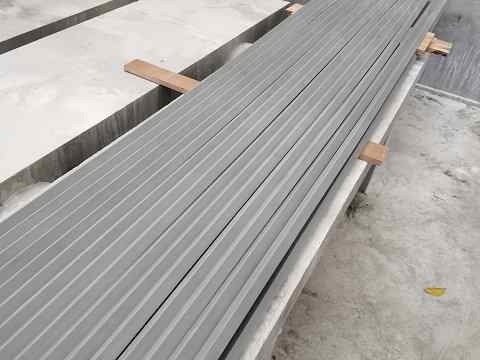Epoxy Water Blocking Strips
- Epoxy water blocking strips play a crucial role in protecting furniture and equipment in the intricate and demanding environment of laboratories,
- These strips, composed of high – performance epoxy materials, have emerged as a highly effective solution, offering specialized protection tailored to the unique needs of lab furniture.
- They provide a reliable barrier against water, chemicals, and other potential contaminants, ensuring the longevity and functionality of lab furniture

Unique Requirements of Lab Furniture
- Traditional waterproofing methods often fall short in such harsh conditions, making epoxy water blocking strips a preferred alternative.
- Lab furniture operates in an environment filled with challenges. Laboratories are often the epicenter of various chemical reactions, involving the use of corrosive acids, alkalis, and organic solvents.
- Frequent washing and cleaning processes, along with accidental spills and splashes, subject lab furniture to constant moisture exposure.
- Moreover, the presence of sensitive scientific instruments and valuable samples stored in lab cabinets demands an environment that is both dry and free from chemical intrusion.
Applications in Lab Sinks
- Lab sinks are one of the most critical areas where epoxy water blocking edges are employed. These sinks are used for washing glassware, disposing of chemical waste, and conducting various wet experiments.
- The joints and edges around the sink are particularly vulnerable to water and chemical seepage. Countertop epoxy water stopper strips, with their exceptional adhesion and chemical resistance, are installed along these areas.
- They form a seamless and impermeable seal, preventing corrosive chemicals from seeping into the underlying cabinetry. For instance, in a chemistry lab where concentrated sulfuric acid and sodium hydroxide are regularly used, the epoxy waterstop strips act as a safeguard, protecting the wooden or metal cabinetry from degradation.
- This not only extends the lifespan of the sink and its surrounding furniture but also reduces the risk of structural damage and potential safety hazards.
Protection for Storage Cabinets
- Storage cabinets in laboratories house a wide range of items, from sensitive analytical instruments to hazardous chemicals. Epoxy water roofing strips play a vital role in ensuring the integrity of these stored items.
- By sealing the doors of the cabinets, the strips prevent moisture from entering, which could otherwise cause rusting of metal parts, degradation of electronic components, or spoilage of chemical reagents.
- In a microbiology lab, for example, where temperature – sensitive cultures and reagents are stored, the waterproof seal provided by the epoxy water barrier strips helps maintain a stable and dry environment. Additionally, in case of accidental spills within the cabinet, the strips confine the liquid, preventing it from spreading to other stored items and causing extensive damage.
Role in Fume Hoods
- Fume hoods are essential pieces of equipment in laboratories, designed to exhaust hazardous fumes and protect laboratory personnel.
- Proper sealing of fume hoods is crucial not only for containing fumes but also for preventing the ingress of water and other contaminants.
- Epoxy water blocking strips are installed around the edges of fume hoods to create a tight and reliable seal. This ensures that any accidental spills or splashes on the exterior of the fume hood do not penetrate inside, safeguarding the internal components and maintaining the efficiency of the ventilation system.
- In a pharmaceutical lab, where highly potent and toxic substances are handled, the secure seal provided by the epoxy waterproof strips is essential for both the safety of the operators and the integrity of the experiments.
Installation and Maintenance
- The installation of epoxy water roofing strips in lab furniture requires careful attention.
- First, the surfaces where the strips are to be applied must be thoroughly cleaned and dried to ensure maximum adhesion. The strips are then precisely cut to fit the required length and carefully placed along the joints or edges.
- Once installed, the epoxy undergoes a curing process, during which it hardens to form a durable seal. Regular maintenance of the strips is also important.
- Periodic inspections should be carried out to check for any signs of wear, damage, or chemical degradation. If any issues are detected, the damaged sections of the strip can be easily replaced, ensuring continuous protection for the lab furniture.
Cost – effectiveness and Long – term Benefits
- While the initial investment in epoxy water resistant strips for lab furniture may seem significant, the long – term benefits far outweigh the costs.
- By protecting lab furniture from water and chemical damage, these strips reduce the frequency of repairs and replacements, saving both time and money in the long run.
- Moreover, the protection they offer to sensitive instruments and valuable samples helps prevent costly losses due to damage or contamination. Additionally, the enhanced safety provided by the strips, by preventing chemical spills and leaks, contributes to a more secure laboratory environment, reducing the risk of accidents and associated liabilities.
- In conclusion, epoxy water blocking edges are indispensable for lab furniture. Their ability to provide a reliable barrier against water, chemicals, and contaminants, combined with their ease of installation and maintenance, makes them an ideal solution for protecting the integrity and functionality of lab furniture. As laboratories continue to evolve and handle more complex and hazardous materials, the importance of these strips in ensuring a safe, efficient, and long – lasting laboratory environment will only increase.
